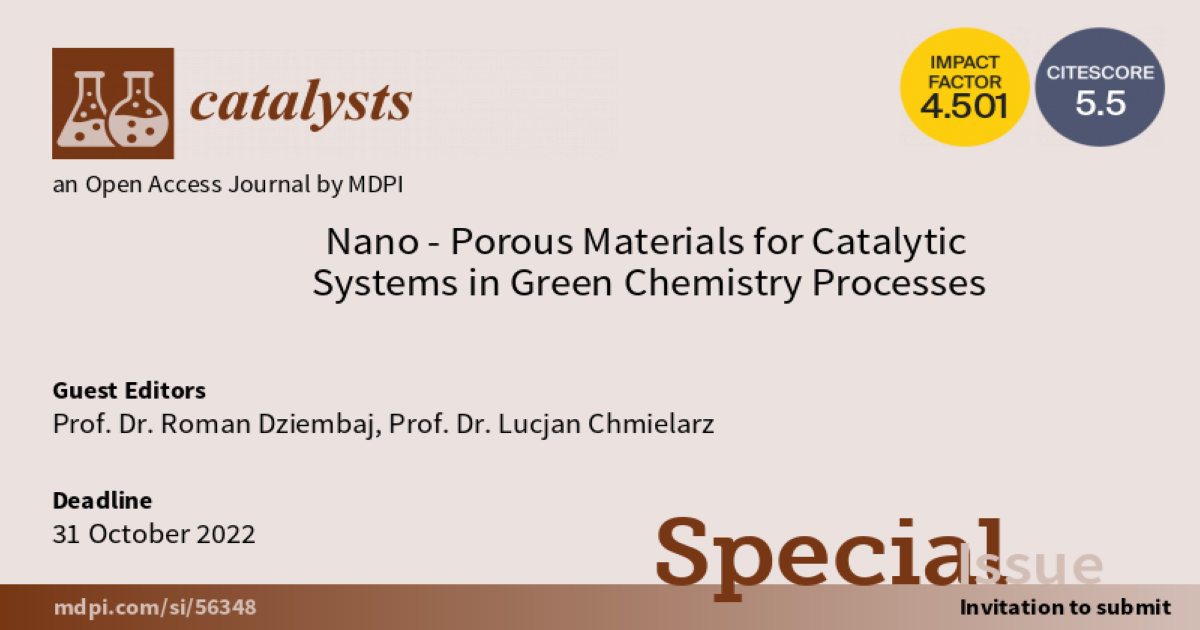Nanocatalysts for Carbon Upcycling
A special issue of Catalysts (ISSN 2073-4344). This special issue belongs to the section "Catalytic Materials".
Deadline for manuscript submissions: closed (30 September 2022) | Viewed by 5760

Special Issue Editors
Interests: catalysts; waste-to-energy; hydrogen; water–gas shift; methane reforming
Special Issues, Collections and Topics in MDPI journals
Interests: hydrogen production; reforming of methane; oxidative dehydrogenation of ethane; battery; electric double-layer capacitors
Special Issues, Collections and Topics in MDPI journals
Special Issue Information
Dear Colleagues,
The Paris Agreement was adopted by 195 countries under the United Nations Framework Convention on Climate Change (UNFCCC) in order to cope with climate change. The aim of the Paris Agreement was to restrict the rise of the global average temperature well below 2 °C above pre-industrial levels and to pursue efforts to limit the temperature increase even further to 1.5 °C by 2100. This international agreement for reducing greenhouse gas (GHG) emissions implies drastic alterations of the energy sector. To accomplish this ambitious goal, efficient, sustainable, and integrated approaches are emerging as the energy sector is on the verge of transformation, driven by technological progress such as electrification, decarbonization, sustainable energy resources, and CO2 capture and storage (CCS) and utilization (CCU).
This Special Issue collects original research papers, reviews, and commentaries focused on the upcycling of carbon. Submissions are welcome in the following areas: synthesis, characterization, application of new catalysts for CCU technology; studies of the activity and stability of the developed catalysts evaluated by conversion rate or turnover frequency; and the identification of intermediates in the catalytic cycle or mechanisms of the catalytic reaction.
Prof. Dr. Hyun-Seog Roh
Prof. Dr. Chang Hyun Ko
Dr. Yeol Lim Lee
Guest Editors
Manuscript Submission Information
Manuscripts should be submitted online at www.mdpi.com by registering and logging in to this website. Once you are registered, click here to go to the submission form. Manuscripts can be submitted until the deadline. All submissions that pass pre-check are peer-reviewed. Accepted papers will be published continuously in the journal (as soon as accepted) and will be listed together on the special issue website. Research articles, review articles as well as short communications are invited. For planned papers, a title and short abstract (about 100 words) can be sent to the Editorial Office for announcement on this website.
Submitted manuscripts should not have been published previously, nor be under consideration for publication elsewhere (except conference proceedings papers). All manuscripts are thoroughly refereed through a single-blind peer-review process. A guide for authors and other relevant information for submission of manuscripts is available on the Instructions for Authors page. Catalysts is an international peer-reviewed open access monthly journal published by MDPI.
Please visit the Instructions for Authors page before submitting a manuscript. The Article Processing Charge (APC) for publication in this open access journal is 2200 CHF (Swiss Francs). Submitted papers should be well formatted and use good English. Authors may use MDPI's English editing service prior to publication or during author revisions.
Keywords
- catalysts
- C1 chemistry
- carbonate synthesis
- carbon capture and utilization
Benefits of Publishing in a Special Issue
- Ease of navigation: Grouping papers by topic helps scholars navigate broad scope journals more efficiently.
- Greater discoverability: Special Issues support the reach and impact of scientific research. Articles in Special Issues are more discoverable and cited more frequently.
- Expansion of research network: Special Issues facilitate connections among authors, fostering scientific collaborations.
- External promotion: Articles in Special Issues are often promoted through the journal's social media, increasing their visibility.
- e-Book format: Special Issues with more than 10 articles can be published as dedicated e-books, ensuring wide and rapid dissemination.
Further information on MDPI's Special Issue polices can be found here.







